Chapter 3
Discovering Live Video on Facebook
In This Chapter
![]() Exploring how streaming live video can enhance your business
Exploring how streaming live video can enhance your business
![]() Choosing a video-streaming application
Choosing a video-streaming application
![]() Setting up a live-streaming application
Setting up a live-streaming application
![]() Marketing your streaming event
Marketing your streaming event
Streaming distributes live video of different types of events, from college football games to company announcements. You can use streaming for branding, product introductions, and business seminars, wherever they are. It’s also a great way for musicians and all kinds of other artists to connect with their fans. Live video gives you an additional communication platform for your event; adding simultaneous real-time chat boxes can make video events even more interesting.
In this chapter, we first look at what live video can mean to you. Then we discuss some of the most popular live-streaming applications available and show you how to set them up. Finally, we tell you how to use tools to get more exposure for your live events.
Understanding the Benefits of Live Video
Streaming adds a whole new social dimension to any event. Here are the reasons why:
- Audience reactions: You can see who is participating in the event and gain insight into how well your event is going over with your audience.
- Increased traffic: The live comments stream drives more traffic to your event or Facebook Page. Viewers post updates to their social networks and bring in more of their friends to watch the event. With a relatively small number of well-connected viewers sharing your content, you don’t need to have a huge budget to create a popular event.
- More social engagement: The most important social addition is the increased engagement you can create for an event because viewers can participate. This is why you want to share your event in the first place, right?
Attracting viewers with chat
Whether live or archived, videos work best when you use them with chat boxes. Viewer comments naturally encourage others to share their own thoughts.
Combining real-time comments with a live video broadcast also helps grow your audience organically during the event itself. Facebook makes it easy to build a larger, more interactive community around your event by displaying users’ chat activity on their friends’ News Feeds, which in turn links back to your site.
These real-time chat boxes (also called “live social streams”) allow thousands of viewers to interact at the same time. Chat boxes are powerful communication tools when they appear on the Page next to your live video content. Chat boxes may also incorporate Share buttons (see Figure 3-1).

Figure 3-1: Live-streaming video with a chat box and Share button.
Getting closer to customers
Facebook is a social platform — where people come to chat with friends. In this social environment, live streaming is a tool that helps businesses get closer to their audience. With a little planning for both social media and offline promotion, businesses can cultivate interaction, create buzz (see the last section of this chapter), and expand their audience.
Supplementing traditional advertising
Given the size of Facebook and the viral nature of social media, presenting live events through Facebook can give you as much visibility as any traditional media advertising. A live chat box helps you engage a large audience for your real-time video.
For example, you do have some control of what appears in chat boxes if you use the Facebook Comments plug-in or Livestream’s chat platform. As an Admin, you can require approval before making comments visible and also blacklist specific words or users. For more information on the Comments plug-in for Facebook, see Chapter 2 of this minibook. For Livestream chat functionality, see http://new.livestream.com/plans.
Choosing Your Streaming Application
You have a few options for streaming video on Facebook, which doesn’t offer its own streaming service. In this chapter, we examine two popular applications: Livestream and 22Social. To better understand third-party applications, go to Book V.
- Livestream for Facebook (http://apps.facebook.com/livestream) supports do-it-yourself video broadcasting and Livestream chat boxes. Livestream offers a free version that links from a Facebook Page tab (as shown in Figure 3-2) to your video hosted on Livestream.com, as shown in Figure 3-3. In most cases, the free version should be all you need to get started. For a modest Basic plan fee of $49 per month, you can get more features. For a hefty monthly fee of $399 for a Premium account, your video will appear directly on your Facebook Page, instead of being hosted by Livestream.
 With a free account, events are deleted automatically 30 days after the original broadcast.
With a free account, events are deleted automatically 30 days after the original broadcast. - 22Social is an app that offers a variety of Facebook marketing services, including the capability to add a Google Hangouts on Air (it’s live video) to your Facebook business Page easily and inexpensively. Other marketing services from 22Social include the simple creation of one-page, custom landing pages, coupons, sweepstakes, surveys, and more, all within Facebook. For more information, see www.facebook.com/22Social/info.

Courtesy of Livestream.
Figure 3-2: With the free version, users click a tab on a Facebook Page that links to Livestream to watch the video.
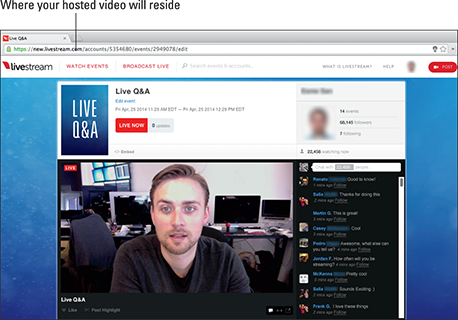
Courtesy of Livestream.
Figure 3-3: If you use the free version, viewers actually watch the real-time video on the Livestream site.
How do you know which application to choose? Your choice depends on what you need to do. See the following minitable.
|
If Your Business Needs This |
Try This |
|
To stream live video to your Facebook community (but the video doesn’t have to be embedded in your Facebook Page) |
Google Hangouts on Air via the 22Social app; free version of Livestream |
|
A robust, professional broadcasting tool and to take full advantage of your Facebook community, without audience size limitations |
Paid Livestream application for publishing videos directly on your Facebook Page |
Streaming from Your Facebook Page with the Livestream Application
Are you ready to try a live video event? With Livestream, you can create your own real-time broadcast and have a real-time chat box at the same time.
Any public event created with either the free or paid version of Livestream is searchable and promoted on the Livestream.com site.
Depending on your plan, your broadcast will be available by clicking a link via a tab, or directly on your Page.
Creating a Livestream account
For either the free or paid Livestream option to broadcast your own video, you also need a Livestream account. (If you want to broadcast from an existing Livestream account, whether that account is your own or someone else’s, you can skip this process.)
To set up a Livestream account, follow these steps:
- Go to https://secure.livestream.com/myaccount/selectwizard.
- On the screen that asks What would you like to do?, click the Broadcast icon.
- At the Livestream Account Center page, enter a name for your channel.
Livestream populates the Short Name and Channel Page fields, and instantly lets you know whether the name is available. (If not, choose a new name.) See Figure 3-4.

Figure 3-4: The Account Center page for Livestream.
- On the same page, click Launch Free Channel or Launch Premium Channel, as shown in Figure 3-5.
With the premium channel, you can stream with no advertisements; however, that channel costs $399 per month. If you’re okay with ads, choose the free channel.
 You need a Premium or an Enterprise level account from Livestream to embed video on your own page.
You need a Premium or an Enterprise level account from Livestream to embed video on your own page. - Enter your sign-up information.
- Click Sign Up in the bottom-right corner.
A Congratulations! screen confirms your sign-up.

Figure 3-5: The two channel launch options.
Creating an event in Livestream
Follow these steps to create an event in Livestream:
- Go to www.livestream.com and click your Profile image in the top right.
- Choose Create Event from the drop-down menu.
- Type your event name in the pop-up window shown in Figure 3-6.
- Click Continue.
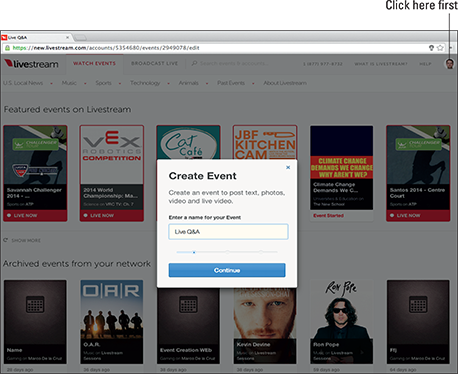
Courtesy of Livestream.
Figure 3-6: Creating a Livestream event and choosing an event name.
- Choose the event start and end dates and then click Continue.
- (Optional) Upload an onscreen digital poster to advertise your event in JPG, GIF, or PNG format.
The graphic file can’t be any larger than 10MB.
- (Optional) Click OK, Let’s Go to customize your event.
You can post text, photos, archived videos, or live videos, or enhance the design, as shown in Figure 3-7. You may want to include your company logo, domain name, and other components to take advantage of this branding opportunity.
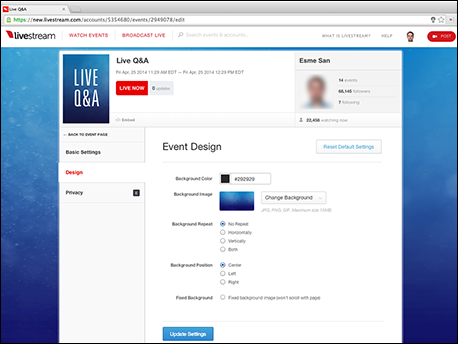
Courtesy of Livestream.
Figure 3-7: Customizing the design of your Livestream event.
Installing the Livestream app on your Facebook Page
After you establish a Livestream account and create an event, you’re ready to install the Livestream application and add it to a Facebook tab on your Page, as follows:
- Log in to your Facebook account.
- Go to http://apps.facebook.com/livestream.
If you haven’t installed the Livestream app, you’re prompted to click Connect Facebook to Install.
- Livestream requires permission to access your basic information in a permissions box called “Public Profile and Friends List.” When you’re prompted with permission questions, click OK.
For example, Livestream requests to “post to Facebook for you” (shown in Figure 3-8). In the bottom-left corner, you can choose to whom these posts should be visible: Public, Friends of Friends, Friends, Only Me, or Custom.
For the details of Livestream’s Terms and Conditions, visit www.livestream.com/terms/generalterms.
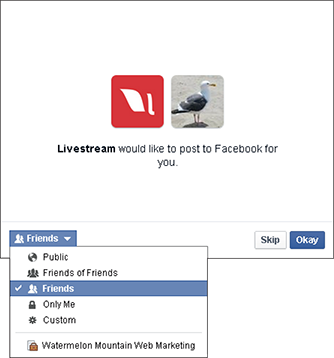
Courtesy of Watermelon Mountain Web Marketing (WatermelonWeb.com).
Figure 3-8: The Livestream request to post publicly to your Facebook Page.
- Find and click Install for the Page where you intend to use the Livestream application (or click Create New Page).
If you already have several Facebook Pages, all are listed below My Pages on Facebook, as shown in Figure 3-9. If you’ve created only one Page, you see only that Page listed.
- If you haven’t logged in to Livestream: Click Login to Livestream on the new screen. When prompted, enter the login credentials you created earlier in this chapter.
- If you’ve logged in to Livestream: You see the Admin dashboard for your Livestream app. The event we show you how to create earlier in this chapter appears here, along with other events you may have created and other potentially interesting events on Livestream. Click Install next to each event you want to present on a tab, as shown in Figure 3-10.
Tah-dah! Your event is being promoted on your Page, as Be Inspired Films’ video event is promoted on its Facebook Page, as shown at the top of Figure 3-11. The event itself will appear on the Livestream site (see the bottom of Figure 3-11). If you upgrade to a Premium or Enterprise account, your Livestream video will be shown on your Facebook Page itself.

Figure 3-9: Select the Page(s) on which you wish to add a Livestream tab.

Figure 3-10: Select the event(s) you want to display on a Livestream tab.

Courtesy of Be Inspired Films (top and bottom).
Figure 3-11: Clicking the promotional Livestream tab on the company’s Facebook Page (top) takes viewers to an event overview (bottom), where they can click the button to watch Be Inspired Films’ video.
Streaming with Google Hangouts on Air with 22Social
Hooking up Google Hangouts on Air with the 22Social app is much simpler than it sounds! Google Hangouts lets users stream video in real time. 22Social lets you embed that streaming video on your Facebook page. Voilà! Free live video.
Creating a Google Hangout on Air
We recommend creating your Hangout on Air before installing the 22Social app. That way, you will have the embed code ready to paste in.
- Go to https://plus.google.com/hangouts to create your Hangout on Air.
- Click the Schedule a Hangout on Air button in the top-right corner.
- Give your Hangout on Air a name and description, decide when to start to stream, and choose the audience.
 For the video stream to appear on your Facebook Page without any problems, leave the audience default to Public. That way, Google+ followers who have you in their circles will be able to view the stream as well. Viewers can see any public Hangout on Air on YouTube.
For the video stream to appear on your Facebook Page without any problems, leave the audience default to Public. That way, Google+ followers who have you in their circles will be able to view the stream as well. Viewers can see any public Hangout on Air on YouTube. - Click the Share button in the bottom left.
 Your YouTube account must be connected.
Your YouTube account must be connected.You are redirected to your Google Hangout on Air Event page.
- Get the code to embed your Hangout on your Facebook Page.
You need this bit of code to insert on the tab that you will create in the next section using the 22Social app.
- Find the Details portion of the event page (on the right side of the page).
- Click the Links button.
- Copy the Video Embed code as shown in Figure 3-12 using Ctrl+C as usual.
For now, keep that code in a safe place by pasting it into a file on your hard drive or on a stick drive.
Installing the 22Social app on your Page
After you have the Google Hangout ready, install the 22Social app on your business Page. Follow these simple steps:
- Go to http://facebook.com/22social.
- Click the tab below the Cover photo that reads “INSTALL. Get 22s Now.”

Courtesy of Watermelon Mountain Web Marketing (WatermelonWeb.com).
Figure 3-12: Retrieve and save the embed code from Google +. You will need to place it on your 22Social tab in order to display your Google Hangout on Air on Facebook.
- Click Like to unlock the app.
The page reloads with a video about the 22Social product and what it can do for your business.
- Click the Install for Free banner below the video. (You may first have to grant the app permission to access your Facebook information.)
A new page offers a Pro version, which you can try for 30 days for $2. If you don’t want the Pro version, navigate to 22s.com/account, which will then direct you to the 22s dashboard for Facebook. Otherwise, you will be required to sign up for the Pro version.
- On the dashboard, click on the green Install Another App button in the top-right corner. You may be prompted to give 22s permission to manage your Pages. Click OK to proceed.
 The free version is all you need for adding a Google Hangout to Facebook. The Pro version offers many other marketing tools that your small businesses may find useful, but which are not needed for live video streaming.
The free version is all you need for adding a Google Hangout to Facebook. The Pro version offers many other marketing tools that your small businesses may find useful, but which are not needed for live video streaming. - You will be taken to the 22s Setup Wizard. From the drop-down menu, choose which Page on which to install your Google Hangout, and click Create App.
- Click the orange pencil button to the left of the Facebook Page that you selected for your video tab. You will then see a preview of the new tab where your Google Hangout on Air will appear.
- On the next screen, customize your Page’s layout, content, and style on the 22s dashboard.
You may want to use a show gate that requires users to like your page before they can view the content on the new tab.
- Click the orange Content button.
- Click the Media button beneath the header.
A pop-up allows you to add your Google Hangout on Air, as shown in Figure 3-13.

Courtesy of Watermelon Mountain Web Marketing (WatermelonWeb.com).
Figure 3-13: Adding your Google Hangout on Air to your 22Social tab.
- Select Streams: Hangout from the Media drop-down menu.
- Enter the Hangout Embed Video Code that you saved in Step 5 into the field below the Media Type drop-down menu.
- Click the green Preview button in the bottom right of the pop-up.
The pop-up disappears.
- Click the green Save button on your new page/tab.
Congratulations! You’ve added your Google Hangout on Air to your Facebook Page. When it’s installed, the hangout will be ready to view by clicking the standard play triangle, as shown in Figure 3-14.
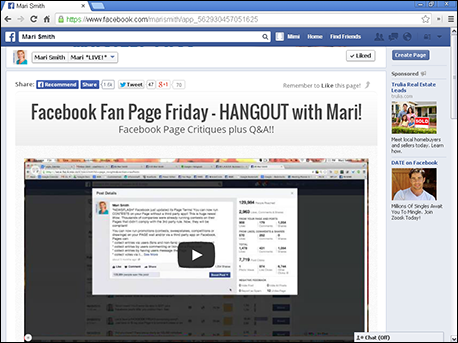
Courtesy of Mari Smith International.
Figure 3-14: A Google Hangout on Air ready to play on a Facebook Page using the 22Social app.
Creating Buzz about Your Live Video
After you have your live stream up and ready to run, you want to get people interested in your live-streaming event both in advance and during the event. This is where your Facebook marketing skills come into play.
Posting to your Facebook Page in advance
Before your live-streaming event, remember to post an update on your Facebook Page to let your audience know what’s coming:
- Tell them about your live-streaming event.
- Tell them why they’ll find it interesting.
- Tell them how they’ll be able to participate.
- Ask them to tell their Friends.
You can also create a Facebook event and promote your upcoming event there. To read more about Facebook Events, go to Book VI, Chapter 1.
Sharing during your event
While your event is going on, be sure to let the audience on your Facebook Page know what’s happening live, and give them the link. Different streaming options have different sharing methods.
For instance, Livestream makes it easy for viewers to share your event, by clicking on the Social Sharing option, as shown in Figure 3-15.

Courtesy of Livestream.
Figure 3-15: Viewers can use social sharing.
By comparison, if you’re using 22Social, the Facebook Comments plug-in is included automatically. For comments to appear on a user’s Timeline, the user must select the Post to Facebook check box before creating a comment. Figure 3-16 shows how comments look when using 22Social.

Courtesy of Mari Smith International.
Figure 3-16: A comment posted in response to a Google Hangout on Air with 22Social may also appear on a user’s personal Profile or Page.
Sharing viewer comments with other social media
It’s easy for viewers to share their comments and your event on multiple social media.
Livestream users can quickly share an event via their Share button to Facebook, Twitter, Tumblr, Google+, or e-mail, as shown in Figure 3-17. Depending on the social network, users can personalize a comment or tweet with a link back to the event.
A similar process applies to users who want to share a real-time video event from the 22Social app.
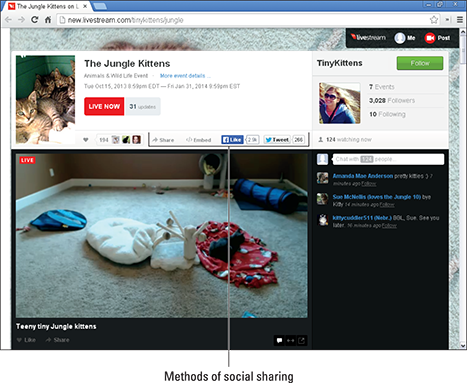
Courtesy of Shelly Roche (TinyKittens.com).
Figure 3-17: Users can share your event on multiple social media.
Calls to action are extremely important during a live-streaming event. Remember, the link generated when people use these social buttons sends people back to the live-stream chat box, bringing in more viewers and facilitating even more interaction around your event.
Partnering with other events and organizers
One cool thing about live streaming is that you don’t actually need to have your own live-streaming video to chat about it. You can create a live-stream chat to talk about someone else’s video content, if you want.
Look for interesting upcoming live-streaming videos on the Livestream new event listings at http://new.livestream.com/home. Check out these events to find content that your audience would love to see.
If you create your own videos, find people who have audiences that are interested in your content, and partner with those people. Your video broadcasts will reach wider audiences, and you’ll build an interactive community experience around your event.
As you look for opportunities to bring content publishers and communities together, remember the opportunities that mobile devices offer. It’s easy to access Facebook on all mobile devices, and it’s also easy to record videos on many of those devices. With so many possibilities, you’re sure to see more live-streaming events.
